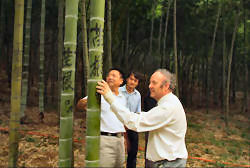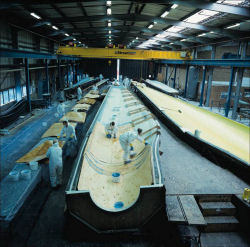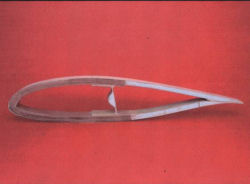All the blades which power the world's growing number of wind turbines are made of composite materials.



However, from the beginning, the best blades have used wood - a naturally growing fibre reinforced composite material - as the primary structural material, comprising some 70% of the weight of the blade. This has been done because wood has superb fatigue behaviour and an unbeatable strength-to-cost ratio and it is also a low energy input material. Over 20 years the wood used has progressed from khaya (African mahogany) to poplar to Finnish birch, birch being the best wood available for this usage in the western world. The only wood available which has better properties than birch is bamboo and a supply route is now being developed for this material.
Since the early 1980s the best blades in the world, designed and manufactured in the UK, have used wood as the primary structural material. The early blades of this type have now completed over 20 years trouble free service. Thousands of these blades have been produced and all follow the same structural pattern of using a hollow shell structure moulded in two halves, with a joining shear web inserted between them as they are bonded together. Typically wood comprises some 70% of the mass of the blade, with the remainder comprising glass cloth, resin and some metal inserts to create the bolted mounting joint at the root end of the blade.
A few years ago, Chinese material resources were rarely considered in relation to technical matters such as this. But bamboo outranks birch as the natural material with the highest properties available, for this kind of application. And if notional values are given to good quality bamboo, the figures show that it outclasses even Finnish birch.
Dr Jim Platts from the Department's Institute for Manufacturing has worked for over twenty years on the design, development and manufacture of the large composite moulded blades for wind turbines, establishing the company Composite Technology (now part of Vestas) as a major contributor in that industry, currently producing high performance blades for wind turbines up to 120 metres diameter. Jim remains interested in the development of the wind turbine industry and technology and helping the industry develop in China.
China is poised to move swiftly to develop its own wind turbine industry to exploit its wind energy capacity which is as large as Europe's. China could so easily have followed the trend of the vast majority of wind turbine manufacturers in the world and used glass and carbon fibres in polymer matrices as the primary structural material for blades. However, Jim and his Chinese partners have shown that bamboo, a sustainable resource, can be used as an alternative to energy-intensive fibres and polymers for this high technology application. The use of bamboo in this way makes wind energy an even more attractive proposition for sustainable electricity generation.

